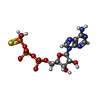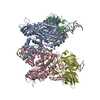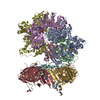[English] 日本語
 Yorodumi
Yorodumi- PDB-7tid: Structure of the yeast clamp loader (Replication Factor C RFC) bo... -
+ Open data
Open data
- Basic information
Basic information
| Entry | Database: PDB / ID: 7tid | |||||||||||||||
|---|---|---|---|---|---|---|---|---|---|---|---|---|---|---|---|---|
| Title | Structure of the yeast clamp loader (Replication Factor C RFC) bound to the sliding clamp (Proliferating Cell Nuclear Antigen PCNA) and primer-template DNA | |||||||||||||||
 Components Components |
| |||||||||||||||
 Keywords Keywords | REPLICATION/DNA / sliding clamp / DNA replication / AAA+ / clamp loader / REPLICATION-DNA complex | |||||||||||||||
| Function / homology |  Function and homology information Function and homology informationDNA clamp unloading / Rad17 RFC-like complex / Mismatch repair (MMR) directed by MSH2:MSH6 (MutSalpha) / Gap-filling DNA repair synthesis and ligation in GG-NER / meiotic mismatch repair / Processive synthesis on the lagging strand / Elg1 RFC-like complex / Removal of the Flap Intermediate / Ctf18 RFC-like complex / DNA replication factor C complex ...DNA clamp unloading / Rad17 RFC-like complex / Mismatch repair (MMR) directed by MSH2:MSH6 (MutSalpha) / Gap-filling DNA repair synthesis and ligation in GG-NER / meiotic mismatch repair / Processive synthesis on the lagging strand / Elg1 RFC-like complex / Removal of the Flap Intermediate / Ctf18 RFC-like complex / DNA replication factor C complex / E3 ubiquitin ligases ubiquitinate target proteins / Polymerase switching / positive regulation of DNA metabolic process / SUMOylation of DNA replication proteins / DNA clamp loader activity / maintenance of DNA trinucleotide repeats / Translesion Synthesis by POLH / Translesion synthesis by REV1 / Translesion synthesis by POLK / Translesion synthesis by POLI / PCNA complex / DNA replication checkpoint signaling / establishment of mitotic sister chromatid cohesion / Activation of ATR in response to replication stress / Termination of translesion DNA synthesis / lagging strand elongation / postreplication repair / silent mating-type cassette heterochromatin formation / sister chromatid cohesion / mitotic sister chromatid cohesion / error-free translesion synthesis / leading strand elongation / DNA polymerase processivity factor activity / Gap-filling DNA repair synthesis and ligation in TC-NER / Dual incision in TC-NER / subtelomeric heterochromatin formation / mismatch repair / translesion synthesis / positive regulation of DNA repair / DNA damage checkpoint signaling / positive regulation of DNA replication / replication fork / nucleotide-excision repair / DNA-templated DNA replication / mitotic cell cycle / chromosome, telomeric region / cell division / DNA repair / ATP hydrolysis activity / DNA binding / ATP binding / identical protein binding / nucleus / cytosol Similarity search - Function | |||||||||||||||
| Biological species |  synthetic construct (others) | |||||||||||||||
| Method | ELECTRON MICROSCOPY / single particle reconstruction / cryo EM / Resolution: 3.3 Å | |||||||||||||||
 Authors Authors | Gaubitz, C. / Liu, X. / Pajak, J. / Stone, N. / Hayes, J. / Demo, G. / Kelch, B.A. | |||||||||||||||
| Funding support |  United States, United States,  Switzerland, Switzerland,  Czech Republic, 4items Czech Republic, 4items
| |||||||||||||||
 Citation Citation |  Journal: Elife / Year: 2022 Journal: Elife / Year: 2022Title: Cryo-EM structures reveal high-resolution mechanism of a DNA polymerase sliding clamp loader. Authors: Christl Gaubitz / Xingchen Liu / Joshua Pajak / Nicholas P Stone / Janelle A Hayes / Gabriel Demo / Brian A Kelch /   Abstract: Sliding clamps are ring-shaped protein complexes that are integral to the DNA replication machinery of all life. Sliding clamps are opened and installed onto DNA by clamp loader AAA+ ATPase complexes. ...Sliding clamps are ring-shaped protein complexes that are integral to the DNA replication machinery of all life. Sliding clamps are opened and installed onto DNA by clamp loader AAA+ ATPase complexes. However, how a clamp loader opens and closes the sliding clamp around DNA is still unknown. Here, we describe structures of the clamp loader Replication Factor C (RFC) bound to its cognate sliding clamp Proliferating Cell Nuclear Antigen (PCNA) en route to successful loading. RFC first binds to PCNA in a dynamic, closed conformation that blocks both ATPase activity and DNA binding. RFC then opens the PCNA ring through a large-scale 'crab-claw' expansion of both RFC and PCNA that explains how RFC prefers initial binding of PCNA over DNA. Next, the open RFC:PCNA complex binds DNA and interrogates the primer-template junction using a surprising base-flipping mechanism. Our structures indicate that initial PCNA opening and subsequent closure around DNA do not require ATP hydrolysis, but are driven by binding energy. ATP hydrolysis, which is necessary for RFC release, is triggered by interactions with both PCNA and DNA, explaining RFC's switch-like ATPase activity. Our work reveals how a AAA+ machine undergoes dramatic conformational changes for achieving binding preference and substrate remodeling. | |||||||||||||||
| History |
|
- Structure visualization
Structure visualization
| Movie |
 Movie viewer Movie viewer |
|---|---|
| Structure viewer | Molecule:  Molmil Molmil Jmol/JSmol Jmol/JSmol |
- Downloads & links
Downloads & links
- Download
Download
| PDBx/mmCIF format |  7tid.cif.gz 7tid.cif.gz | 485.4 KB | Display |  PDBx/mmCIF format PDBx/mmCIF format |
|---|---|---|---|---|
| PDB format |  pdb7tid.ent.gz pdb7tid.ent.gz | 385.2 KB | Display |  PDB format PDB format |
| PDBx/mmJSON format |  7tid.json.gz 7tid.json.gz | Tree view |  PDBx/mmJSON format PDBx/mmJSON format | |
| Others |  Other downloads Other downloads |
-Validation report
| Summary document |  7tid_validation.pdf.gz 7tid_validation.pdf.gz | 1.6 MB | Display |  wwPDB validaton report wwPDB validaton report |
|---|---|---|---|---|
| Full document |  7tid_full_validation.pdf.gz 7tid_full_validation.pdf.gz | 1.6 MB | Display | |
| Data in XML |  7tid_validation.xml.gz 7tid_validation.xml.gz | 78 KB | Display | |
| Data in CIF |  7tid_validation.cif.gz 7tid_validation.cif.gz | 117.5 KB | Display | |
| Arichive directory |  https://data.pdbj.org/pub/pdb/validation_reports/ti/7tid https://data.pdbj.org/pub/pdb/validation_reports/ti/7tid ftp://data.pdbj.org/pub/pdb/validation_reports/ti/7tid ftp://data.pdbj.org/pub/pdb/validation_reports/ti/7tid | HTTPS FTP |
-Related structure data
| Related structure data |  25617MC  7thjC  7thvC  7ti8C  7tibC  7ticC  7tkuC M: map data used to model this data C: citing same article ( |
|---|---|
| Similar structure data |
- Links
Links
- Assembly
Assembly
| Deposited unit | 
|
|---|---|
| 1 |
|
- Components
Components
-Replication factor C subunit ... , 5 types, 5 molecules ABCDE
| #1: Protein | Mass: 95048.195 Da / Num. of mol.: 1 Source method: isolated from a genetically manipulated source Source: (gene. exp.)  Gene: RFC1, CDC44, YOR217W, YOR50-7 / Production host:  |
|---|---|
| #2: Protein | Mass: 36201.039 Da / Num. of mol.: 1 Source method: isolated from a genetically manipulated source Source: (gene. exp.)  Gene: RFC4, YOL094C, O0923 / Production host:  |
| #3: Protein | Mass: 38254.543 Da / Num. of mol.: 1 Source method: isolated from a genetically manipulated source Source: (gene. exp.)  Gene: RFC3, YNL290W, N0533 / Production host:  |
| #4: Protein | Mass: 39794.473 Da / Num. of mol.: 1 Source method: isolated from a genetically manipulated source Source: (gene. exp.)  Gene: RFC2, YJR068W, J1808 / Production host:  |
| #5: Protein | Mass: 39993.582 Da / Num. of mol.: 1 Source method: isolated from a genetically manipulated source Source: (gene. exp.)  Gene: RFC5, YBR087W, YBR0810 / Production host:  |
-Protein , 1 types, 3 molecules FGH
| #6: Protein | Mass: 29525.713 Da / Num. of mol.: 3 Source method: isolated from a genetically manipulated source Source: (gene. exp.)  Gene: POL30, YBR088C, YBR0811 / Production host:  |
|---|
-DNA chain , 2 types, 2 molecules IJ
| #7: DNA chain | Mass: 9172.891 Da / Num. of mol.: 1 / Source method: obtained synthetically / Source: (synth.) synthetic construct (others) |
|---|---|
| #8: DNA chain | Mass: 6136.008 Da / Num. of mol.: 1 / Source method: obtained synthetically / Source: (synth.) synthetic construct (others) |
-Non-polymers , 3 types, 9 molecules 




| #9: Chemical | ChemComp-AGS / #10: Chemical | ChemComp-MG / #11: Chemical | ChemComp-ADP / | |
|---|
-Details
| Has ligand of interest | Y |
|---|
-Experimental details
-Experiment
| Experiment | Method: ELECTRON MICROSCOPY |
|---|---|
| EM experiment | Aggregation state: PARTICLE / 3D reconstruction method: single particle reconstruction |
- Sample preparation
Sample preparation
| Component | Name: yeast clamp loader (Replication Factor C RFC) bound to the sliding clamp (Proliferating Cell Nuclear Antigen PCNA) and primer-template DNA Type: COMPLEX / Entity ID: #1-#8 / Source: MULTIPLE SOURCES |
|---|---|
| Molecular weight | Value: 0.351 MDa / Experimental value: NO |
| Source (natural) | Organism:  |
| Source (recombinant) | Organism:  |
| Buffer solution | pH: 7.5 |
| Specimen | Embedding applied: NO / Shadowing applied: NO / Staining applied: NO / Vitrification applied: YES |
| Vitrification | Cryogen name: ETHANE |
- Electron microscopy imaging
Electron microscopy imaging
| Experimental equipment |  Model: Titan Krios / Image courtesy: FEI Company |
|---|---|
| Microscopy | Model: TFS KRIOS |
| Electron gun | Electron source:  FIELD EMISSION GUN / Accelerating voltage: 300 kV / Illumination mode: FLOOD BEAM FIELD EMISSION GUN / Accelerating voltage: 300 kV / Illumination mode: FLOOD BEAM |
| Electron lens | Mode: BRIGHT FIELD / Nominal defocus max: 2300 nm / Nominal defocus min: 1200 nm |
| Image recording | Electron dose: 40 e/Å2 / Film or detector model: GATAN K3 (6k x 4k) |
- Processing
Processing
| Software | Name: PHENIX / Version: dev_3699: / Classification: refinement | |||||||||||||||||||||||||||
|---|---|---|---|---|---|---|---|---|---|---|---|---|---|---|---|---|---|---|---|---|---|---|---|---|---|---|---|---|
| EM software |
| |||||||||||||||||||||||||||
| CTF correction | Type: PHASE FLIPPING AND AMPLITUDE CORRECTION | |||||||||||||||||||||||||||
| Symmetry | Point symmetry: C1 (asymmetric) | |||||||||||||||||||||||||||
| 3D reconstruction | Resolution: 3.3 Å / Resolution method: FSC 0.143 CUT-OFF / Num. of particles: 76270 / Symmetry type: POINT | |||||||||||||||||||||||||||
| Atomic model building | Protocol: FLEXIBLE FIT / Space: REAL | |||||||||||||||||||||||||||
| Atomic model building | PDB-ID: 1SXJ Accession code: 1SXJ / Source name: PDB / Type: experimental model | |||||||||||||||||||||||||||
| Refine LS restraints |
|
 Movie
Movie Controller
Controller













 PDBj
PDBj











































